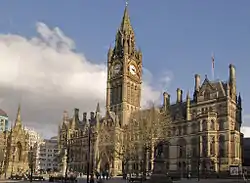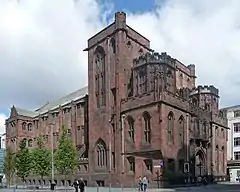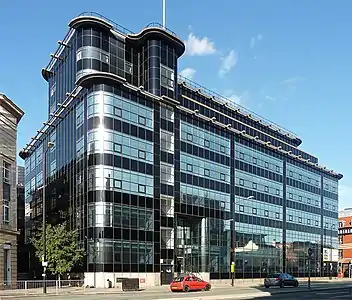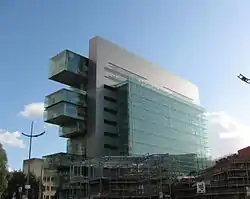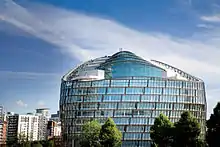Wythenshawe Hall
Wythenshawe Hall is a 16th-century medieval timber-framed historic house and former manor house in Wythenshawe, Manchester, England, five miles (8 km) south of Manchester city centre in Wythenshawe Park. Built for Robert Tatton, it was home to the Tatton family for almost 400 years. Its basic plan is a central hall with two projecting wings.
| Wythenshawe Hall | |
|---|---|
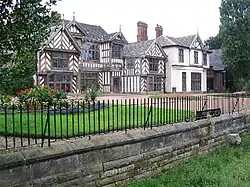 Wythenshawe Hall in 2005 | |
| Location | Wythenshawe, Manchester |
| Coordinates | 53°24′17.4″N 2°16′40″W |
| Built | 1540 |
Listed Building – Grade II* | |
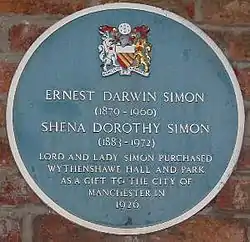
In the winter of 1643–44 the house was besieged by Parliamentarian forces during the English Civil War. Despite the stout defence put up by Robert Tatton and his fellow Royalists, the defenders were overwhelmed by the Roundheads' superior weaponry.
Rebuilding work was carried out at the end of the 18th century, and various additions made in the 19th century, including a walled garden, an ice house, glass houses and a tenant's hall.[lower-alpha 1] Wythenshawe Hall and its surrounding parkland were donated to Manchester Corporation in 1926, and in 1930 it was opened to the public as a museum.
The building was badly damaged in an arson attack in March 2016; repairs were expected to be completed by late 2019.[2]
History
A pre-1300 charter mentions an enclosed deer park in Wythenshawe where the Tatton family owned land in 1297.[3] Around 1540, Robert Tatton of Chester[4] built Wythenshawe Hall as the Tatton family residence.[5] The timber-framed Tudor house[6] was the home of the family for almost 400 years.[4] and may originally have had a moat.[3]
The hall was besieged during the English Civil War over the winter of 1643–44 by Robert Duckenfield's Parliamentarian forces. It was defended by Royalists led by Robert Tatton until the Roundheads brought two cannons to the hall from Manchester, leading to the Royalist surrender on 27 February 1644.[5] The Parliamentarian's subsequently confiscated Wythenshawe Hall, but it was returned to the Tatton family on payment of a fine of just over £700. After recovering the estate, the family expanded it to about 2,500 acres (1,000 ha).[7]
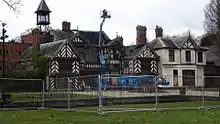
In 1924 Robert Henry Grenville Tatton inherited the Wythenshawe estate. There was interest from Manchester Corporation, who wanted land to build a garden suburb,[8] ostensibly to rehouse tenants from slum clearance. By April 1926 Wythenshawe Hall and 250 acres (1 km2) of its surrounding estate had been sold to Ernest and Shena Simon, who donated them to Manchester Corporation "to be used solely for the public good".[9] Later that year the corporation purchased the rest of the estate,[10][11] and went on to build one of the largest housing estates in Europe on the land.
Repairs were made to the hall in the 1950s,[12] and it was listed as a Grade II* structure on 25 February 1952.[13] Its former stable block, to the west of the hall, was Grade II listed in 1974.[14]
The roof of the hall and an upper floor were severely damaged by a fire that started at around 3:30 am on 15 March 2016; the clock tower was also damaged.[4] On 23 March, Jeremy Taylor of Wythenshawe was charged with arson in connection with the fire.[12][15][16] In July 2017, after changing his plea and admitting guilt, he was sentenced to four and a half years in prison.[17] The hall was added to the Heritage at Risk Register in October 2016.[18] A planning application to restore the building was submitted in November 2016, with the intention of keeping as much of the original material as possible;[12] as of August 2017, the building was scaffolded and undergoing repairs under a protective roof.[17]
Architecture
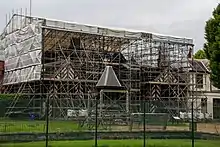
The hall was partially rebuilt between 1795 and 1800 by Lewis Wyatt.[3][13] It was altered around 1840 possibly by Edward Blore.[3] Additions included a walled garden, an ice house, and glass houses.[5] In the Victorian era the dining room was refurbished and a tenant's hall was added.[19]
The timber-framed manor house has a hall with two projecting wings, and a porch and dais bays.[6][20] The entrance hall (also known as the ante-room) is thought to have previously been a chapel, which was subsequently turned into a billiards room, before becoming an entrance hall in the 1870s.[19]
Museum
In 1930, the hall was turned into a museum and art gallery.[6] Most of the hall's original furniture was removed by the Tatton family in 1926 when they moved out, and most of the furniture and paintings displayed in the hall during its time as a museum were from the Manchester City Galleries collection.[19]
Until 2007 a re-enactment of the 1643 siege of Wythenshawe Hall by Cromwell's troops was staged every July.[21]
By 2004 the hall was only open once a week for four months in the year[22] and in 2010 closed completely[6] as a result of council spending cuts.[23] One proposition was that Manchester City Council could sell the building to the National Trust.[24] In summer 2012 the hall re-opened for 10 days for the Wythenshawe Games.[25] A friends group was established in September 2012 to hold monthly open days and regular events at the hall.[6][26] Furniture installed by the friends group (including a four-poster bed engraved with the Tatton family crest) was not damaged by the fire.[27]
Park
Wythenshawe Park occupies 270 acres (1.1 km2) of land surrounding the hall in Northern Moor. The park contains a mix of woodland, bedding, borders, grassland and meadows,[28] sports and games facilities, and Wythenshawe community farm and a horticulture centre[29] North Lodge, the Grade II listed gate lodge on the park's northern boundary was built in the Tudor style in the mid to late 19th century.[30] A Grade II listed bronze statue of Oliver Cromwell on a granite plinth and pedestal in the park is dated 1875, and was originally located at Deansgate.[31][32][33]
See also
| Wikimedia Commons has media related to Wythenshawe Hall. |
References
Notes
- Hospitality, traditionally doled out to visitors, freeholders and tenants at country and manor houses in the Middle Ages, became a drain on the family's purse. Rather than abandoning the practice, in some houses from the 18th century the tenants and other visitors on business were still entertained to refreshments but in a tenant's hall in the servant's quarters rather than the great hall or parlour. It was where rents were paid and some houses held celebratory dinners at Christmas or family occasions attended by members of the family.[1]
Citations
- Girouard, Mark (1978). Life in the English Country House: A Social and Architectural History. Yale University Press. pp. 189. ISBN 978-0-300-05870-3.
- Yarwood, Sam (10 October 2017). "It could be another two years before arson struck Wythenshawe Hall is finally back open". men.
- Historic England. "Wythenshaw Park (1000857)". National Heritage List for England. Retrieved 23 March 2016.
- "Fire destroys roof of historic Wythenshawe Hall in Manchester". BBC News. 15 March 2016. Retrieved 18 March 2016.
- "Wythenshawe Park". Manchester Council. Retrieved 18 March 2016.
- "Wythenshawe Hall - Pastscape". Historic England. Archived from the original on 18 March 2016. Retrieved 18 March 2016.
- "Wythenshawe Hall". Wythenshawe's History and Heritage. Wythenshawe History Group. Retrieved 1 December 2017.
- "The Wythenshawe estate". The Manchester Guardian (1901–1959). 17 January 1921.
- "Splendid gift to Manchester". The Manchester Guardian. 13 April 1926.
- "The Wythenshawe estate". The Manchester Guardian. 13 October 1926.
- Riley, Peter (1999), Wythenshawe Hall and the Tatton Family (Revised ed.), Peter Riley, p. 22, ISBN 1-874712-38-7
- "Planning application submitted to begin repair works at fire-ravaged Wythenshawe Hall". Manchester Evening News. 8 November 2016.
- Historic England. "Wythenshawe Hall (Grade II*) (1255034)". National Heritage List for England. Retrieved 18 March 2016.
- Historic England. "Former stable block to west of Wythenshawe Hall (Grade II) (1255038)". National Heritage List for England. Retrieved 18 March 2016.
- "Man charged with arson following fire that engulfed Wythenshawe Hall". Manchester Evening News. 23 March 2016. Retrieved 23 March 2016.
- "Wythenshawe Hall blaze: Man, 26, charged with arson". BBC News. 23 March 2016. Retrieved 23 March 2016.
- "Wythenshawe Hall fire: Man jailed for arson attack". BBC News. 18 August 2017.
- "Fire-ravaged Wythenshawe Hall added to Historic England's at risk register". Manchester Evening News. 21 October 2016.
- "Wythenshawe Hall - The Ante-room" (PDF). Manchester City Council. Retrieved 19 March 2016.
- Pevsner, Nikolaus (1969). Lancashire. 1. The industrial and commercial south. The Buildings of England. p. 343.
- "Axe falls on family festival". Manchester Evening News. 29 August 2007. Retrieved 18 March 2016.
- "Plea for historic gem". Manchester Evening News. 8 May 2004.
- "Wythenshawe Park: The Hall". Manchester Council.
- Linton, Deborah (1 June 2011). "Budget crisis could lead Manchester council to give away Heaton Hall and Wythenshawe Hall". Manchester Evening News. M.E.N. Media.
- "Wythenshawe Games 2012 - WCHG". 28 May 2012. Retrieved 30 November 2017.
- "Friends of Wythenshawe Hall". Friends of Wythenshaw Hall. Retrieved 10 November 2013.
- "Easter at Wythenshawe Hall will go ahead with a little help from our Friends". Manchester City Council. 22 March 2016. Retrieved 23 March 2016.
- "About the park". Manchester Council. Retrieved 19 March 2016.
- "Facilities in the park". Manchester Council. Retrieved 19 March 2016.
- Historic England. "North Lodge of Wythenshawe Hall (Grade II) (1255036)". National Heritage List for England. Retrieved 18 March 2016.
- Historic England. "Statue of Oliver Cromwell approx.100m east of Wythenshawe Hall (Grade II) (1255035)". National Heritage List for England. Retrieved 18 March 2016.
- "Oliver Cromwell". Public Monument and Sculpture Association. Retrieved 18 March 2016.
- "Listed buildings in Manchester by street (W)". Manchester City Council. Retrieved 18 March 2016.
